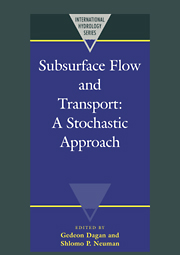1 - Stochastic approach to subsurface flow and transport: a view to the future
Published online by Cambridge University Press: 04 December 2009
Summary
STATISTICAL CHARACTERIZATION OF GEOLOGIC COMPLEXITY
Subsurface flow and transport parameters such as permeability, porosity and dispersivity have been traditionally viewed as well-defined local quantities that can be assigned unique values at each point in space. Yet subsurface flow and transport take place in a complex geologic environment whose lithologic, petrophysical and structural makeups vary in ways that cannot be predicted deterministically in all of their relevant details. These makeups tend to exhibit discrete and continuous variations on a multiplicity of scales, causing flow and transport parameters to do likewise. In practice, such parameters can at best be measured at selected well locations and depth intervals, where their values depend on the scale (support volume) and mode (instrumentation and procedure) of measurement. Estimating the parameters at points where measurements are not available entails a random error. Quite often, the support of measurement is uncertain and the data are corrupted by experimental and interpretive errors. These errors and uncertainties render the parameters random and the corresponding flow and transport equations stochastic.
Though the uncertain nature of flow and transport parameters is now widely recognized, there does not yet appear to be a consensus about the best way to deal with it mathematically. The most prevalent approach has been that represented by the geostatistical school of thought. According to this philosophy, parameter values determined at various points within a more-or-less distinct hydrogeologic unit can be viewed as a sample from a random field defined over a continuum. This random field is characterized by a joint (multivariate) probability density function or, equivalently, its joint ensemble moments.
- Type
- Chapter
- Information
- Subsurface Flow and TransportA Stochastic Approach, pp. 231 - 241Publisher: Cambridge University PressPrint publication year: 1997
- 19
- Cited by

